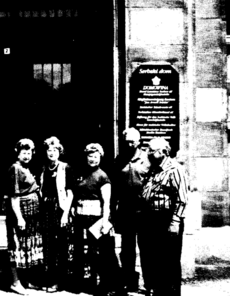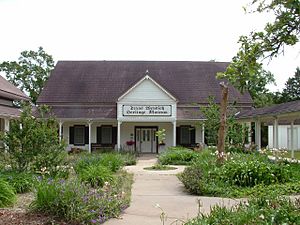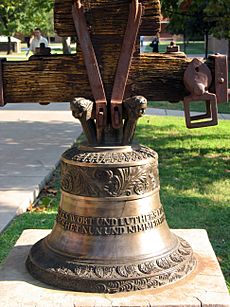Wends of Texas facts for kids
The Texas Wends are a special group of people in Texas. They are descendants of about 558 Wendish people who moved from a place called Lusatia in modern-day Germany to Texas in 1854. Their leader was a pastor named John Kilian.
The word "Wends" refers to the Sorbian people, a Slavic group living in Germany. While other Wendish people also moved to Texas, this group was the largest and most important for keeping Wendish culture alive in the state.
Contents
History of the Texas Wends
Why They Left Home
In 1817, the King of Prussia, Frederick William III, made a rule. He wanted the Lutheran and Reformed churches in his land to join together. This created the Evangelical Church of the Prussian Union.
Many Lutherans did not agree with this change. They were called Old Lutherans. They decided to leave the official churches and start their own. Many of them moved to places like America and Australia.
The Wends were part of this group. They were also unique because they were a Slavic minority. They lived in an area that was mostly German. They wanted to keep their own beliefs and culture.
On March 23, 1854, many Wendish people met in a town called Dauban. They decided to move away to find religious freedom. On May 25, 1854, they chose John Kilian to be their pastor. Soon after, they started planning their big move to Texas.
Their Long Journey to Texas
The Wends first traveled to Hamburg, Germany. From there, they went to Hull, England. They thought they would get on one big ship there. But when they arrived, they found two smaller ships instead.
After some talks, they were taken to Liverpool, England. There, they finally boarded a ship called the Ben Nevis. It was part of the White Star Line.
While in Liverpool, a serious sickness called cholera was spreading. After their ship sailed, they had to stop in Queenstown, Ireland. The ship was quarantined, meaning no one could leave or enter. This was to make sure the sickness passed.
They eventually arrived in Galveston, Texas. They passed the health check there. But Galveston, the biggest city in Texas at the time, had yellow fever. So, they quickly moved on to Houston. By the time they left Galveston, 73 people had died from different illnesses. Fifty-five of those deaths were from cholera.
Starting a New Life in Texas
When they got to Houston, many Wends did not have enough money. They could not pay to travel further inland. So, they walked, carrying what they could. Some stopped in other German towns along the way.
Finally, the main group reached what is now Lee County. They started a new settlement called Low Pin Oak. Today, this place is known as Serbin, Texas.
Their first winter was very hard. They lived in simple dug-outs and small shelters. But in the next year, they built their first church and school. They worked hard to keep their culture alive.
Pastor Kilian continued to lead them. He preached in both Sorbian and German. Later, he even added English to his sermons. German became very common in the community. Even the gravestones for Kilian and his family were carved in German. His sons continued to preach and teach in Wendish. But after them, the Wendish language was not used much in the colony.
During the Civil War
The Wends believed in hard work. They had moved to Texas for freedom. Because of this, they did not think it was right to own slaves. Many Wendish families grew cotton on their farms.
During the American Civil War, it was hard to sell cotton. The Union Navy blocked the ports. But the Wends found a way. They smuggled cotton to sell in Europe. This helped the economy and avoided federal troops.
Some Wendish men joined the war. They served in a group called 1st Battalion Infantry, Waul's Texas Legion. They were recruited by Captain Robert Voigt. In 1863, this group was captured by federal troops. They were sent to Yazoo City. One Wendish man, Johann Kieschnik, was a shoemaker. His captors immediately asked him to make shoes for them. Sadly, several Wendish men became very sick and died while they were held captive.

The Twentieth Century and Beyond
As time went on, more land and jobs became available. This led many Wends to start new communities and churches. They spread throughout Texas and then across the United States. This movement grew even more after World War II. Many Wendish families moved to cities around the world.
During this time, Concordia University Texas started to study the Texas Wends. They wanted to learn about their journey and history. This led to the creation of the Texas Wendish Heritage Museum. It is located near the original St. Paul Church in Serbin.
This study helped bring the Wends back together. In 1988, they started a special event called the Wendish Festival. It still happens every year. In the 1990s, the Wends also began to visit the Domowina. This is a Sorbian organization in Lusatia, Germany. They have kept strong ties with the Wends who still live there.
Texas Wends Today
The towns of Serbin, Warda, and Giddings still have many descendants of the original Wendish pioneers. There are not many Wendish-speaking pastors left. But the culture is kept alive by the Texas Wendish Heritage Museum.
The museum is in Serbin, Texas. It publishes a newsletter and hosts the yearly Wendish Festival. It also organizes trips for Wends to visit the Domowina in Germany. The museum is open all year. It has special events to celebrate Wendish traditions and history.
Since the 1970s, there has been a renewed interest in Wendish culture. The Texas Wendish Heritage Society works to preserve their history. The museum has over 3,000 artifacts and documents. It also has original log buildings from John Kilian's time. These items tell the story of this unique group.
The Wendish Fest has been held every year since 1988. It takes place on the fourth Sunday in September. People from all over the world come to share stories. They eat traditional Wendish Noodles and streusel coffee cake. They also take part in fun competitions, like cross-cut saw challenges. This festival helps keep the Wendish way of life alive. They still decorate eggs in their special cultural style. And their egg noodles are always a favorite food.
The original church bell was brought from Lusatia. It used to be in the St. Paul Lutheran Church's bell tower. Now, it is at Concordia University Texas in Austin. This university was founded by Texas Wends. It is connected to the Lutheran Church–Missouri Synod.
Other Sources
- Blasig, A. (1957) The Wends of Texas. The Naylor Company. San Antonio, Texas.
- Caldwell, L. (1961) Texas Wends: Their first half-century - With historical, biographical & genealogical information on the Serbin Wends, the Schatte & Moerbe families in particular. (The Anson Jones Press. Salado, Texas)
- Cravens, Craig and David Zersen, editors. Transcontinental Encounters: Central Europe Meets the American Heartland (Austin, TX: Concordia University Press, 2005)
- Engerrand, G.C. (1934) So-Called Wends of Germany and their Colonies in Texas and Australia. (University of Texas bulletin, no. 3417. Austin, Texas: The University) ISBN: 0-88247-188-0
- Grider, S. (1982) The Wendish Texans. (The University of Texas Institute of Texan Cultures. San Antonio, Texas) ISBN: 0-86701-000-2.
- Malinkowa, T. (2009) Shores of Hope: Wends Go Overseas (Austin: Concordia University Press) ISBN: 978-1-881848-12-7
- Malinkowa, Trudla, ed. 2014. Jan Kilian (1811–1884). Pastor, Poet, Emigrant. Sammelband der internationalen Konferenz zum 200. Geburtstag des lutherischen Geistlichen, Bautzen, 23.–24. September 2011. Papers of the International Conference on the Occasion of the 200th Birthday of the Lutheran Minister, Bautzen, 23–24 September 2011. [each chapter in both German & English] Bautzen: Domowina Verlag.
- Nielsen, G. (1989) In Search of Home, Nineteenth-Century Wendish Immigration (College Station: Texas A & M University Press) ISBN: 0-89096-400-9.
- Wukasch, Charles. A Rock Against Alien Waves: A History of the Wends Second Edition (Austin: Concordia University Press, 2008)
- Zersen, David. An Exciting Find in a Wendish Vault in Texas. Concordia Historical Institute Quarterly. Fall 2012.
- Zersen, David, ed. The Poetry and Music of Jan Kilian (Austin: Concordia University Press, 2011)




